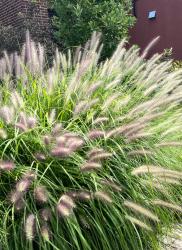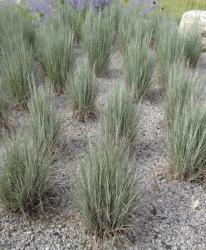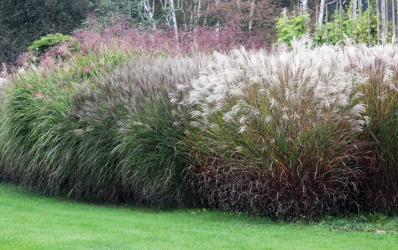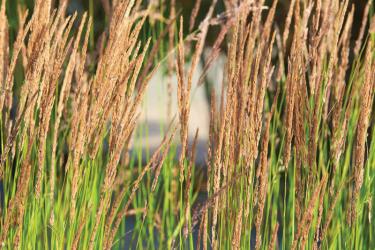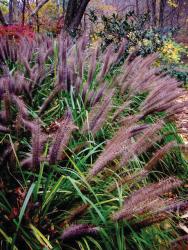With gracefully arching, dark green foliage, the Pennisetum alopecuroides “Red Head” routinely turns heads even before its huge, smoky-rose plumes appear in late summer. Like most ornamental grasses, “Red Head” prefers rich soil but is quite adaptable so long as it gets adequate moisture. Best planted in full sun in early summer, but make sure you place these plants well since they root deeply and are a challenge to dig up and transplant. Cut it down to about 2 to 3 inches every year in the first week of March. Kathie Hoyer, Bowood Farms.
Our favorite ornamental grass is Foerster's Feather Reed Grass, or Calamagrostis x acutiflora “Karl Foerster.” You can create a stunning vertical effect with feathery stalks that emerge reddish brown in spring and turn a rich golden color in fall. This grass blooms two to three weeks earlier than common feather reed grass. Foerster’s Feather thrives in wet soils, yet tolerates drier conditions, and its stalks make great cut flowers. Its sterile seeds do not produce unwanted seedlings. David Sherwood, Sherwood’s Forest Nursery.
A beloved Missouri native grass, Little Bluestem, Schizachyrium scoparium, forms upright clumps of slender blue-green leaves that are tinged bluer at the base. Summer through fall, its leaves and stems are an ever-changing color show, displaying hues of gray-green, blue, pink, purple, copper, mahogany, red and orange. Little Bluestem is a tough and dependable clumping grass that blends well with other sun-loving perennials such as coneflowers, black-eyed-susans, blazing star and other grasses. An important pollinator plant, Little Bluestem is a larval host for a variety of butterflies and moths. Native to North America, it was one of the dominant grasses of the vast tall-grass prairies. They are easy to grow in full sun in average soil and are deer resistant. Ann Lapides, Sugar Creek Gardens.
Schizachyrium scoparium, “The Blues,” Little Bluestem is best planted in a landscape berm, rock garden or foundation planting. It performs best with full sun exposure. It also provides year-round interest with its electric blue foliage and shots of red stems. In the fall, you can expect a brilliant show of color from this grass. Plant this between frost dates from the end of April to mid-October. It has a low water requirement; once this plant is established, it performs well with minimal water needs and shows great drought resistance. Avoid using too much fertilizer and water as well as insufficient sunlight, as these can cause the plant to flop. Justin Verbryck, Frisella Nursery.
Our favorite is the Shenandoah Switchgrass; known for its pink plumes and burgundy tint in the fall, it brings gorgeous color to your garden. Once established, this grass only needs occasional watering though it will require more in the first year. It does best in full-sun locations, and it is fast growing. Shenandoah Switchgrass grows to around four feet tall and two to three feet wide when in full bloom. We recommend using this as a border plant or for erosion control. Max Snyder, Schmittel’s Nursery.
Pennisetum alopecuroides, aka fountain grass, is a warm seasonal grass with a compact, round arching habit. It’s easy to grow, prefers the sun and will tolerate drought once established. It blooms mid to late summer, and is noted for its foxtail-like flower. There are many excellent cultivars available; a favorite is “Moudry,'' noted for its distinctive dark purple spikes. Timberwinds Nursery.


